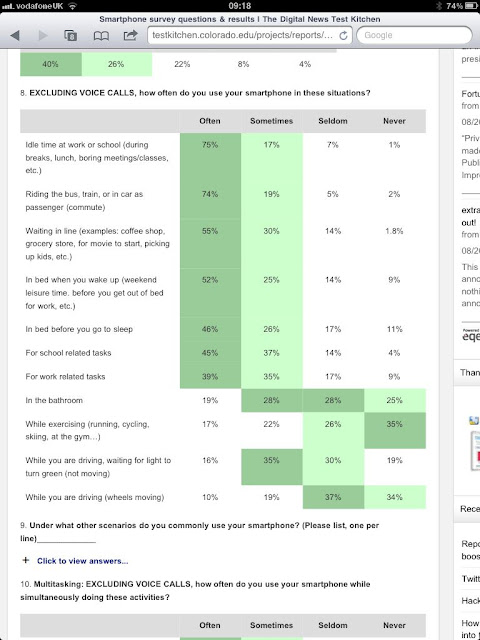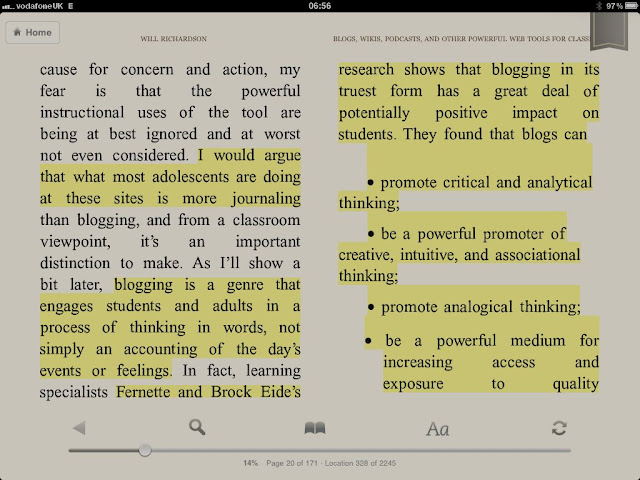Q1. In the light of the podcast and this week's work, consider how you might revise the way in which you are making notes on studies. Do the questions from 1.4 need elaborating?
Questions : what research questions are being addressed?
Setting : what is the sector and setting?
Concepts : what theories, concepts and key terms are being used?
Methods : what methods if data collection and analysis are used?
Findings : what did this research find out?
Limitations : what are the limitations of the methods used?
Implications : what are the implications (if any) for practice, policy or further education?
1) I will still ask, what was the problem? What is the hypothesis? I may ask why this research is being carried. I will certainly look at who the authors are, how the research is funded and the methods used.
2) There's more to setting than a name and an address for where and when something took place. It matters and helps to know the context, the time, people and environment.
3) They may only be noticed if they are unusual or controversial, but there will be reasons why a certain theory or concept is used. This will put a slant on the research, because of the choices made by the authors, the choices that are current and appropriate and whether they have been used before and what the conclusions were then. Activity Theory, for example, is going through changes, Diffusion of Innovation theory transmogrified with the idea of a ‘chasm’. Activity Theory is becoming ‘Cultural Historical’
4) Methods are taking advantage of computers to gather and analyse data, including 'big data' in new and revealing ways.
5) There is inertia of approaches and adopting new technologies, even a bias towards conformity and 'old ways' of doing things which is how and why the breakthroughs and disruption tends to come from outside.
6) The implications are for HE and schools to try to do what industry has been doing for the last 20 years – to embrace change as a constant to be embraced, rather than as a rare occurrence to be resisted. New ways of doing things, new ways if undertaking research, new ways of analysing and sharing the data and outcomes.
7) Keep an open mind. Have a set of questions that require a comprehensive view and be prepared to be a magpie - to think outside these parameters in terms of scope, depth and spread – so cross disciplinary, historic as well as the future.
PODCAST
Interviewer : James Axcel
Interviewees : Dr Peter Twining (PT), Head of Department of Education + Prof. Grainne Conole (GC), Professor of E–learning
Some highlights:
'We've got that rhetoric reality gap where people talks it up (or down) and say what a great thing it is (or dreadful) and it's going to allow us to transform, whatever, and in reality it’s having very little impact on pedagogy in practice'. Grainne Conole (2007)
I've add the opposites in brackets as this is what I find happens in the press - journalists and authors either say X is a bad thing or will create a revolution (which they see as a good thing). A few years ago Nicholas Carr got far to much 'air play' saying that Goolge was making us stupid, while a decade before that Marc Prensky claimed that his take on the 'plastic brain' meants that an entire generation could be defined as 'digital natives'.
GC Has been a shift. Recognition that ICT is critical. Higher Education (HE).
High Education more joined up with HEFCE, JISC and Dfes.
Still a lot of collaborations.
Department for Education and Skills
Impact of Government
PT Students use technology automatically – so education should train skill you up for this and it should be applied in education.
GC How assesses .. every bit, technology transformation ...
Surprise at how little has been done.
Can't disentangle it.
GC Young people immersed. Love being in a technology environment. GC's 9 year old (recorded)
Peter's PhD research a number of frameworks for looking at education.
ICT in education, the confusion, use of terms to mean completely different things, so confusing, impossible to explore describing changes, get the terms, then look at the tools.
Five different types of frameworks related specifically to ICT in learning.
1) Achievements – measuring individual's progress in terms of their learning and using ICT.
2) Cognitive frameworks – impact on the individual, how they think,what's happening in their heads.
3) Software frameworks – the types of software being used, drill and skill, adventure programme, open ended, tutor–tool–tutee. vs. Technology determined.
4) Pedagogical frameworks – the nature of the interaction around computer use as a machine. Teacher, student and computer.Squires and Mcdougal's Perspectives Intersections Paradigm.
5) Evolutionary frameworks – how ICT is being rolled out in a system or classroom.
GC issue if clarity a real problem, with fads and terms.
GC clarification and classification of frameworks is important. The benefits of frameworks is that the do orher some perspective, some view, to give some clarity.
GC See a nice little pretty diagram and that explains things and that's it! It is used without understanding its depth.
- A conflict between trying to understand while keeping the depth.
- Jonassen Perseptives, backgrounds – constructive, positive ...
- Fads and trends, constructition and social construction very popular over the last three decades.
Laurillard's conversational – dialogic nature of learning, in contrast to AT for the relationships.
PT underneath the technology the pedagogy translates.
GC People get beguiled and carried away by the technology. Views in Web 1.0 apply to Web 2.0.
PT What is the educational vision? What is the tool we want to use? How we design, how it fits in, a complex change process.
GC Social is important, but learning is learning, and is also individual. Moved from computer aided learning ...
PT A VLE is made to fit current practitioners.
GC Do something amazing – and got repetiton of standard practice, into a very narrow band, depsite millions of permutations.
Q2. Look back at Reading 1 and consider the questions that were asked in that research. Do you think they represent a dominant ‘paradigm’ for research in any particular period? Are the research questions and methods still relevant today?
As a business study SWOT analysis McKinsey 7 or for its versatility AT or CHAT would be more likely a way to address the complex interactions that occur in a learning environment where the only variable that ought to be different would be the ‘tool’ as VC rather than TC.
Both are required and complement each other. Greater ‘triangulation’ of the research may have given it more credibility or at least exposed more about the circumstances of the research. Untried methods should have been identified and reasons given for their not being used.
The research questions had quite an influence on the design of the research.
‘Viable option’ in terms of results, costs and other support and inputs. Worse, the same or better than traditional. More or less expensive to put on and run. More or less appropriate for students and instructors. Always felts this was exploratory, may have needed to demonstrate either way that it had a future.
Cannot be the assumptions of the research, rather it should come from the students as participants and instructors as other players. If they were missed then technical staff ought to have been questioned too as both technical and cost barriers would have been an issue.
REFERENCE
Jonassen, D.H. (1996) Computers in the Classroom: methods for critical thinking.
Laurillard, D (2002) Rethinking University Teaching
Squires, D. and McDougall, A. (1994) Choosing and Using Educational software: a teacher's guide.
Twining, P. (2002) 'Enhancing the Impact of Investments in "Educational" ICT (online) PhD Thesis, The OU. http://kn.open.ac.uk/public/document.cfm?documentid=2515

